12 Best AI Note Takers You Should Know

In the endless stream of meetings, calls, and brainstorming sessions, crucial information often gets lost. The mental effort required to actively listen, participate, and simultaneously capture accurate notes is immense, leading to missed details and forgotten action items. This is the precise problem that the best AI note takers are designed to solve. These powerful tools act as your personal assistant, diligently transcribing conversations, summarising key points, and organising your thoughts so you can focus on the discussion at hand.
This guide moves beyond generic marketing claims to provide a detailed, hands-on analysis of the top AI note-taking platforms available today. I have personally tested each tool to give you a clear picture of its real-world performance. You will find in-depth reviews covering everything from user interface and transcription accuracy to advanced features like sentiment analysis and workflow automation. My goal is to help you cut through the noise and find the right solution for your specific needs, whether you're a digital marketer tracking client calls, an entrepreneur capturing strategic insights, or a content creator organising research.
Each review is structured for clarity, featuring:
- An honest assessment of pros and cons.
- Practical examples relevant to professionals.
- Detailed pricing breakdowns.
- Screenshots to illustrate the user experience.
- Direct links to explore each platform further.
I will be examining a comprehensive list of contenders, from well-known platforms like Otter.ai and Notion AI to specialised meeting assistants like Fireflies.ai and Fathom. By the end of this article, you will have a clear understanding of which AI note taker best aligns with your workflow, budget, and professional objectives, empowering you to reclaim your focus and never lose a valuable idea again.
1. Notion
Notion has evolved from a powerful, all-in-one workspace into a formidable contender in the race for the best AI note takers. Its strength lies not in being a dedicated note-taking app, but in integrating AI seamlessly into a broader productivity ecosystem. This means you can take meeting notes, manage projects, and maintain a knowledge base all in one place, with AI assistance at every step. The platform's AI can summarise lengthy documents, draft emails, generate tables from unstructured text, or even brainstorm ideas directly within your notes, making it an incredibly versatile tool.
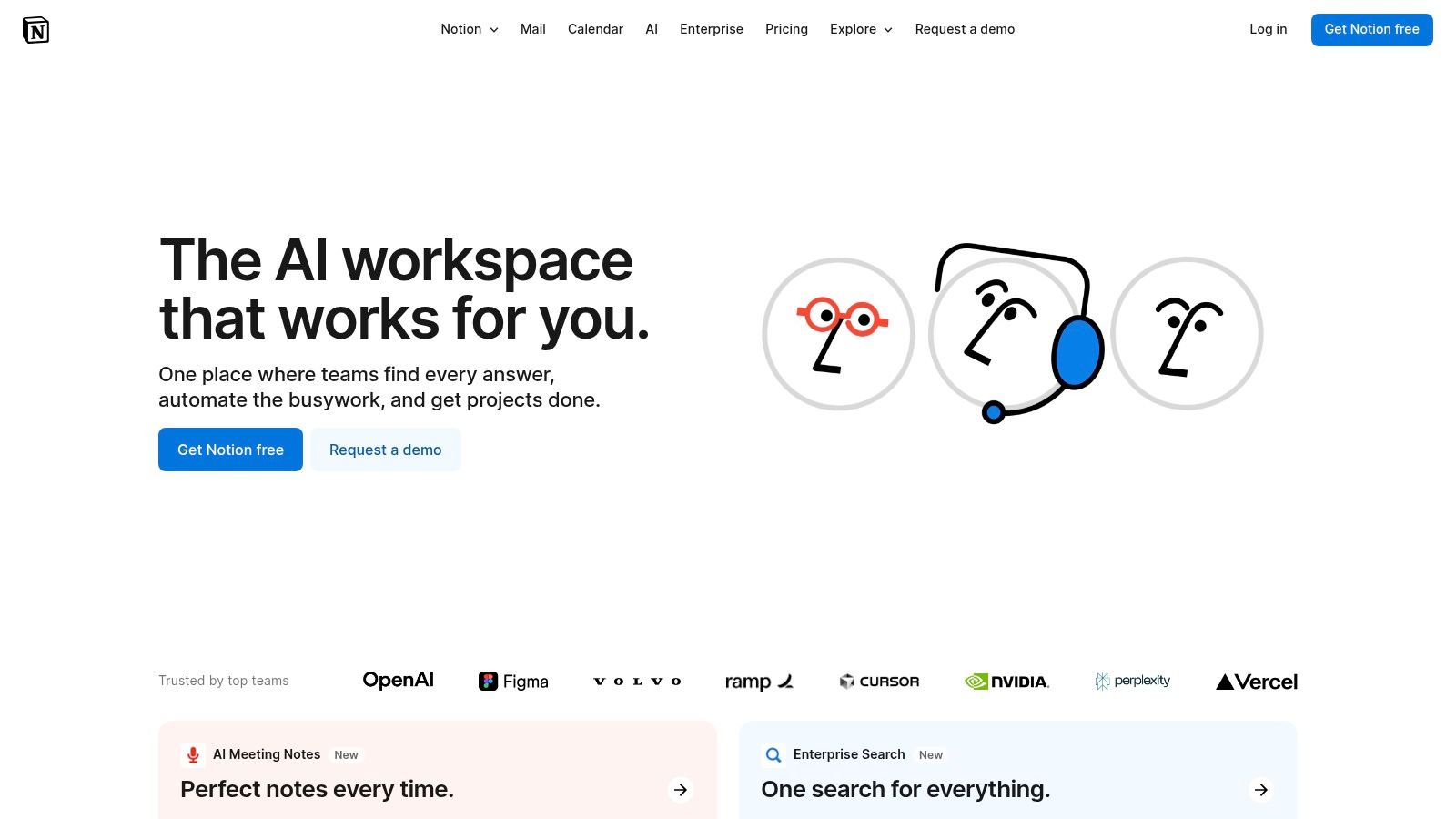
What truly sets Notion apart is its customisable nature. While there's a learning curve, its block-based editor and extensive template library allow you to build a system perfectly tailored to your workflow. For instance, I use it to create a central hub for client projects, where the AI helps me generate initial project outlines and summarise weekly progress reports for stakeholders. This approach is supported by experts like Thomas Frank, who showcases complex Notion setups on his popular YouTube channel, demonstrating its power for building comprehensive life and business management systems.
Key Features & User Experience
- Integrated AI Assistant: Accessible directly within any page to generate, edit, or summarise content.
- Customisable Databases: Organise notes with tags, properties, and different views (e.g., Kanban boards, calendars).
- Collaborative Workspace: Real-time editing and commenting make it ideal for team-based note-taking and project management.
- Vast Template Ecosystem: A huge library of user-created and official templates for everything from content calendars to personal journals.
The user interface is clean and minimalist, though mastering its full potential can take time. The AI features are generally intuitive, activated by a simple command.
Pricing and Practical Considerations
Notion offers a generous free plan for individuals. For AI features and enhanced collaboration, paid plans start from $8 per user/month (billed annually) for the Plus plan. The AI is available as an add-on to any plan (including free ones) for an additional monthly fee. This modular pricing can be a drawback if you only need the AI component. However, for those already embedded in the Notion ecosystem, adding the AI is a logical and powerful upgrade.
Pro Tip: Utilise Notion's database relations feature. I link my meeting notes database to my projects database. This way, any notes I take using the AI summariser during a call are automatically associated with the relevant project, creating an organised, interconnected knowledge base.
Website: https://www.notion.so/
2. Otter.ai
Otter.ai is less of a traditional note-taking app and more of a dedicated, real-time transcription powerhouse, making it one of the best AI note takers for anyone whose work revolves around spoken conversations. It excels at turning meetings, interviews, and lectures into accurate, searchable text almost instantly. The platform’s AI, the OtterPilot, can automatically join your Zoom, Google Meet, or Microsoft Teams calls, record the audio, and provide a live transcript, distinguishing between different speakers.
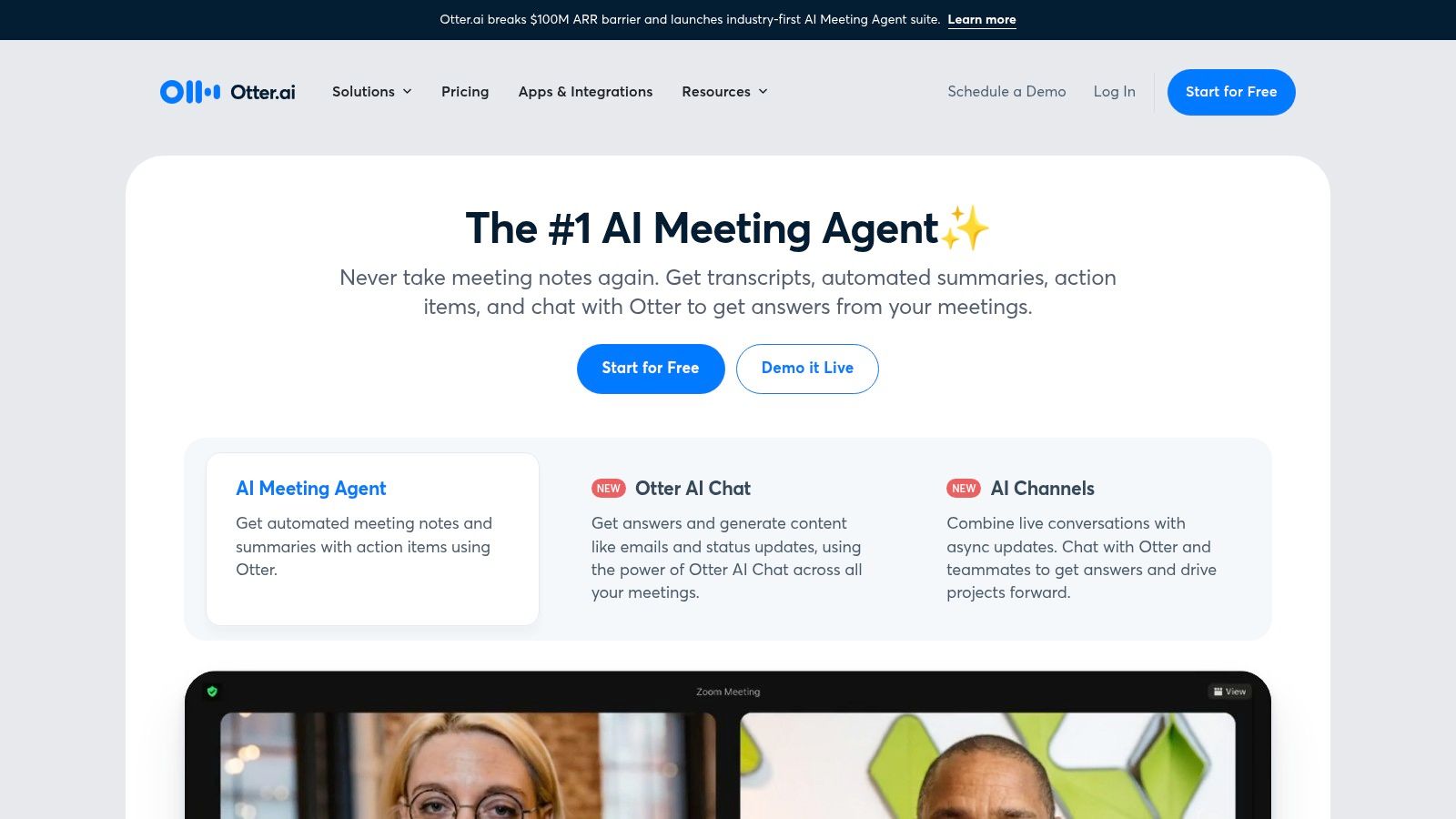
What makes Otter.ai so indispensable is its focus on making voice content actionable. After a meeting, its AI generates a concise summary, outlines key discussion points, and lists action items, saving me hours of relistening to recordings. A practical example is using Otter.ai for user research interviews. After a 30-minute call, I can have a full transcript and an AI summary ready to share with my design team in under five minutes, dramatically speeding up the feedback loop. This specialisation is its greatest strength; while it doesn't offer the broad project management features of Notion, its transcription accuracy and automated summaries for spoken content are currently unparalleled.
Key Features & User Experience
- Real-Time Transcription: Get live transcripts during meetings with impressive accuracy and speaker identification.
- AI Meeting Summaries: Automatically generates summaries, outlines, and action items post-meeting.
- Seamless Calendar Integration: OtterPilot can auto-join and record scheduled meetings from your calendar.
- Collaborative Highlights & Comments: Teams can highlight key parts of a transcript and add comments in real-time.
The user interface is clean and straightforward, centred entirely around your conversations. Transcripts are easy to read, search, and edit.
Pricing and Practical Considerations
Otter.ai has a Basic free plan that offers transcription for a limited number of meetings per month. For more extensive use, paid plans start from the Pro plan at £9.99 per user/month (billed annually), which offers significantly more transcription minutes and advanced features. A key limitation is its primary focus on English, although it handles various accents well. While not an all-in-one workspace, its specialised function is a lifesaver for anyone who attends numerous virtual meetings.
Pro Tip: Use the "Custom Vocabulary" feature to teach Otter.ai specific jargon, acronyms, or names that are common in your industry or company. For example, I added terms like "SEO" and "SERP" to my vocabulary, which significantly improves transcription accuracy for my specific use case over time.
Website: https://otter.ai/
3. Fireflies.ai
Fireflies.ai carves out its niche not as a general-purpose note-taking app, but as a dedicated AI meeting assistant. Its primary function is to join your calls, record them, and then deliver highly accurate transcriptions and actionable summaries. For anyone whose work revolves around meetings – project managers, sales teams, or consultants – it stands out as one of the best AI note takers because it automates the most tedious part of the process, freeing you up to focus on the conversation itself. The platform integrates directly with major video conferencing tools like Zoom, Google Meet, and Microsoft Teams, acting as a silent participant that handles all the documentation.
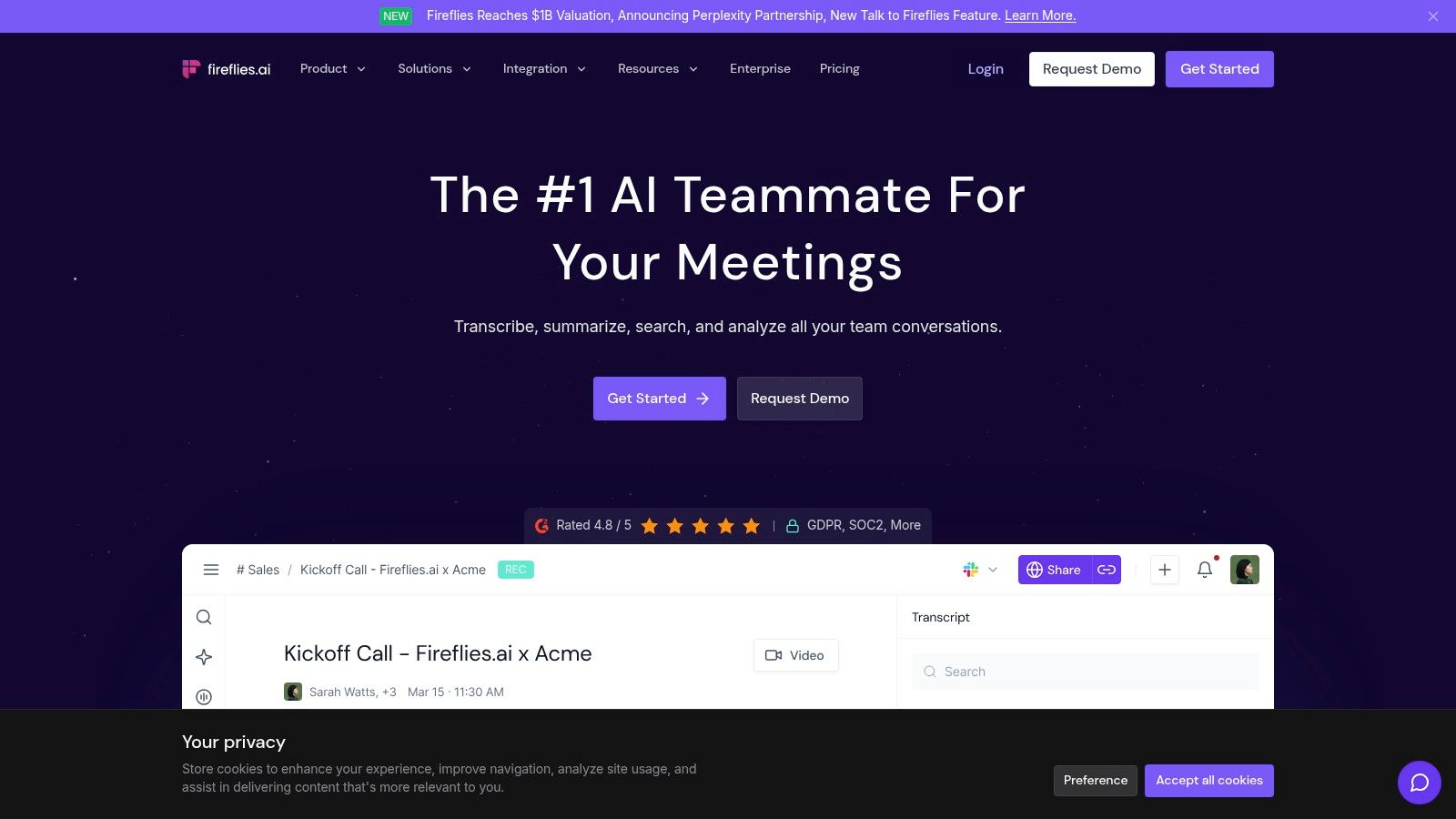
What makes Fireflies.ai so powerful is its post-meeting analysis. It doesn't just give you a wall of text; it provides AI-powered summaries, identifies key action items, and allows you to search the entire transcript for specific keywords or topics. I find it indispensable for client debriefs, as I can easily revisit crucial decisions or feedback without having to re-listen to an entire hour-long recording. For example, in a sales context, the platform's sentiment analysis can flag parts of a call where a client expressed concern, allowing for targeted follow-up. This type of deep analysis is highlighted in a Gartner report on the rise of "conversation intelligence" platforms, where tools like Fireflies are becoming critical for sales and support teams.
Key Features & User Experience
- Automated Transcription & Summarisation: Joins your meetings automatically and provides detailed, time-stamped transcripts and AI-generated summaries.
- Broad Integration: Works seamlessly with popular calendars and video-conferencing platforms.
- Conversation Intelligence: Analyses metrics like talk time, sentiment, and topic trends to provide deeper insights into your meetings.
- Collaborative Tools: You can add comments, create soundbites, and share specific parts of the meeting with team members.
The user interface is clean and centred around your meeting history. Navigating transcripts and summaries is intuitive. While transcription accuracy is very high, it can sometimes struggle with strong accents or poor audio quality.
Pricing and Practical Considerations
Fireflies.ai offers a free tier with limited transcription credits and storage, which is great for trying it out. Paid plans start from the Pro tier at $10 per user/month (billed annually), which offers significantly more transcription credits and features like AI summaries. The Business tier provides enhanced analytics and team features. This model makes it accessible for individuals and scalable for larger organisations.
Pro Tip: Use the "Custom Vocabulary" feature. I add specific industry jargon, client names, and project codenames to my Fireflies.ai account. This significantly improves the transcription accuracy for my specialised conversations, ensuring the AI correctly identifies key terms in summaries and action items.
Website: https://fireflies.ai/
4. ClickUp
ClickUp positions itself as the "one app to replace them all," and its venture into AI-powered note-taking reinforces this claim. Rather than being a standalone tool, its AI features are deeply embedded within a comprehensive project management suite. This makes it one of the best ai note takers for teams who need their meeting notes, action items, and project timelines to live in one unified, collaborative space. The AI can instantly summarise meeting notes, generate action items from discussions, and even draft project briefs directly within a task.
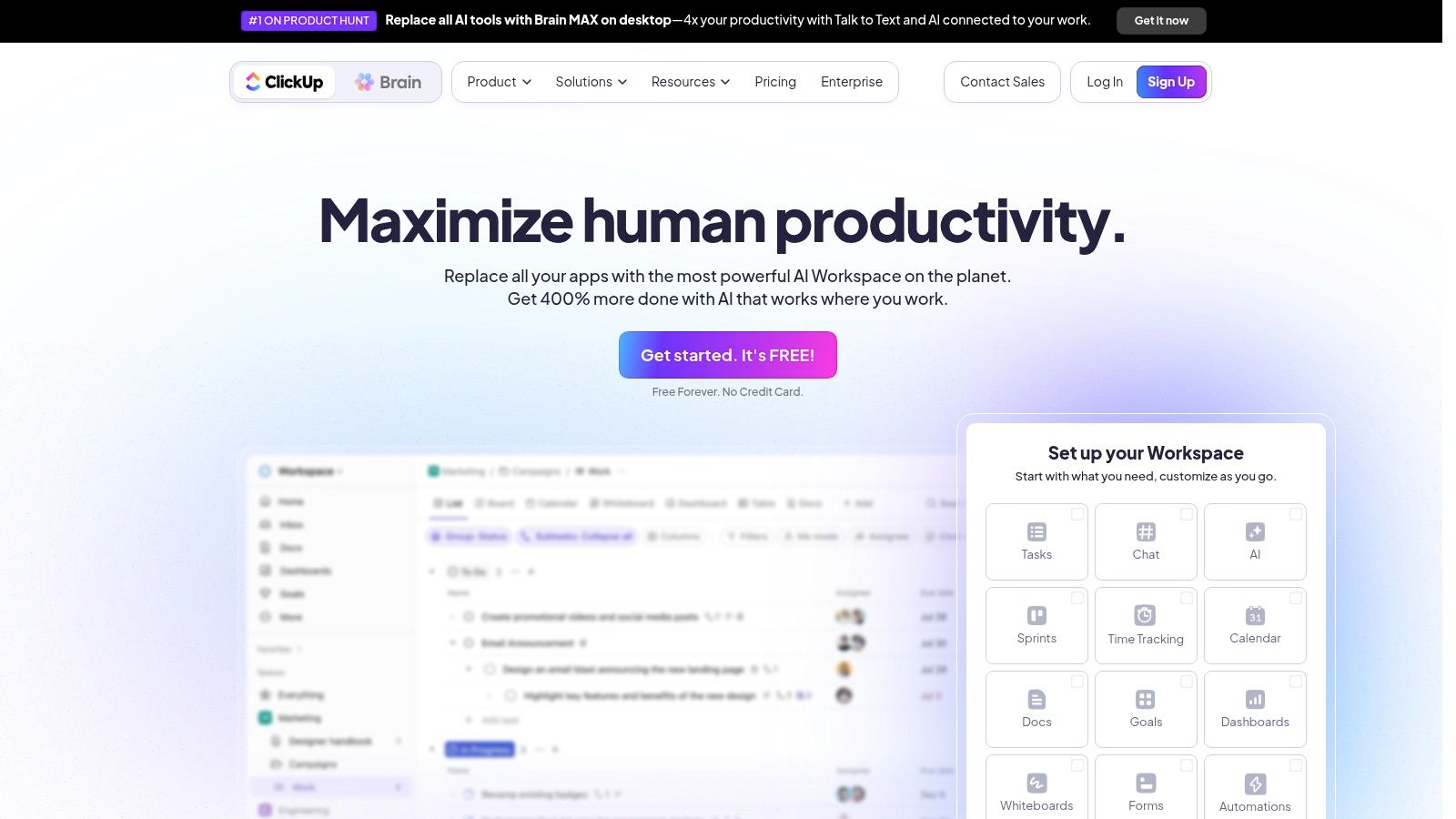
What makes ClickUp powerful is its context-aware AI. Because it understands your projects, tasks, and deadlines, its suggestions are highly relevant. For example, when I use the AI to summarise a brainstorming session for a new marketing campaign, it not only creates a concise summary but also suggests creating new tasks and assigning them to team members, directly linking them back to the original project doc. This level of integration streamlines workflow significantly.
Key Features & User Experience
- Integrated AI Assistant: Available across Docs, tasks, and comments to summarise, write, and edit content.
- Customisable Workspaces: Offers multiple views like Lists, Boards, and Calendars, allowing teams to organise notes and tasks in a way that suits them.
- Rich Third-Party Integrations: Connects seamlessly with apps like Slack, Google Drive, and Figma, centralising all project-related information.
- Hierarchical Structure: Organise everything from high-level company goals down to individual sub-tasks and checklists.
The user interface is feature-rich, which can feel overwhelming for new users. However, its customisability means you can hide unnecessary features to simplify your workspace.
Pricing and Practical Considerations
ClickUp offers a generous "Free Forever" plan with a good number of features. To unlock the full power of its AI assistant and more advanced project management tools, paid plans are necessary, starting from £7 per user/month (billed annually) for the Business plan. The AI is available as a paid add-on for any workspace plan. The sheer number of features presents a steeper learning curve compared to more focused note-taking apps.
Pro Tip: Use ClickUp's "Relationships" feature to link your AI-generated meeting notes directly to relevant tasks or goals. This creates a traceable path from discussion to execution, ensuring no action item gets lost and providing clear context for why a task exists.
Website: https://clickup.com/
5. Notta
Notta positions itself as one of the best AI note takers by focusing intently on one core task: exceptionally accurate, real-time audio transcription and summarisation. While other tools bundle note-taking into a larger productivity suite, Notta excels by dedicating its AI to capturing spoken words from meetings, lectures, and interviews with precision. Its standout feature is the extensive language support, making it an indispensable tool for global teams and multilingual professionals who need reliable records of their conversations.
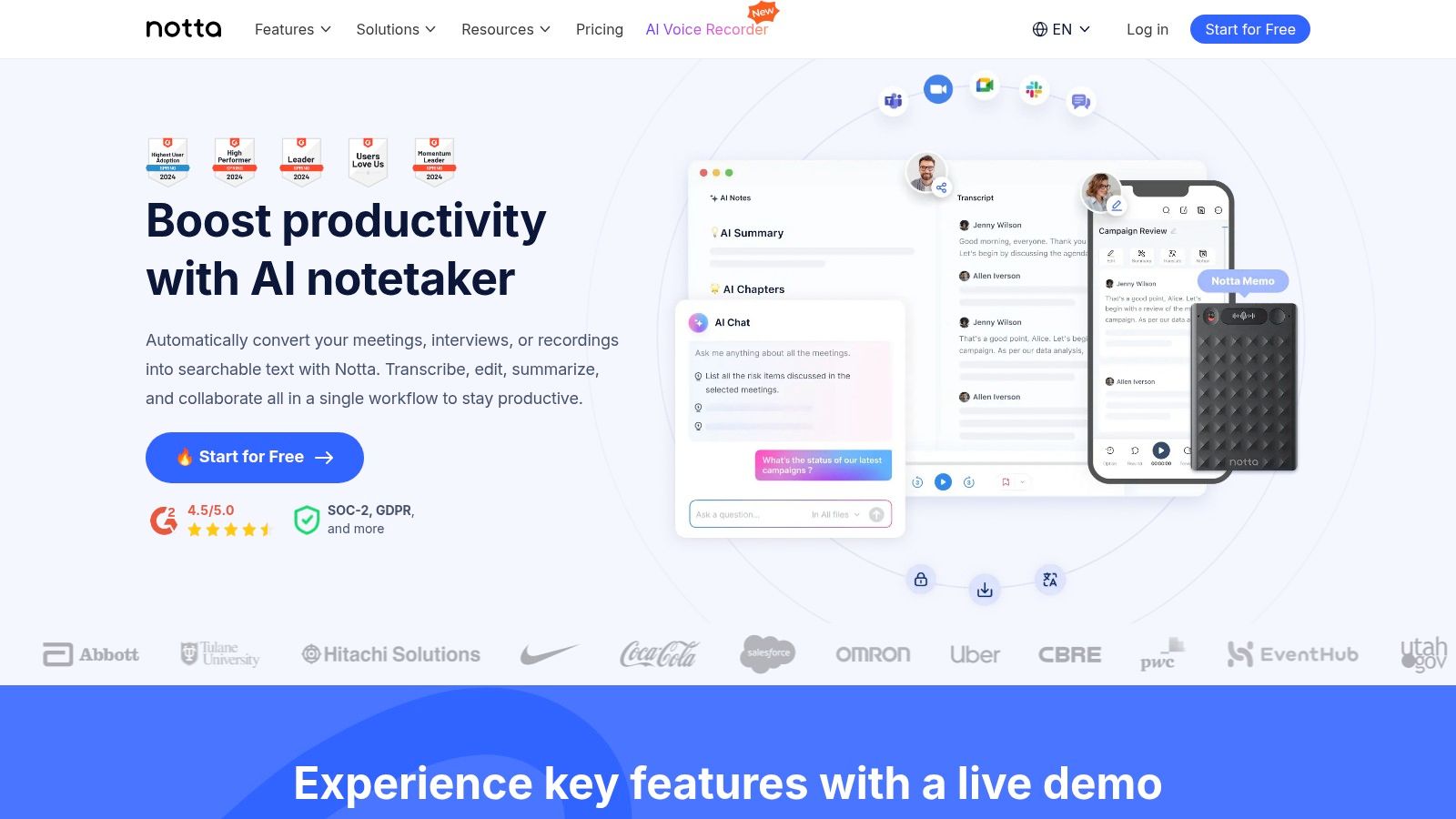
What makes Notta particularly effective is its seamless integration with meeting platforms. The Notta Bot can join your Zoom, Google Meet, or Microsoft Teams calls automatically, acting as a dedicated stenographer. I find this invaluable for international client calls, as it transcribes everything in real-time and provides an AI-generated summary with action items moments after the call ends, eliminating the need for manual note-taking and allowing me to stay fully engaged in the discussion. A practical example is for journalists, who can record an interview in a foreign language and get both the original transcript and an English translation almost instantly, a process that used to take days and significant cost.
Key Features & User Experience
- Real-time Transcription: Captures and converts speech to text live during meetings or from audio uploads.
- Extensive Language Support: Accurately transcribes in 58 languages, a significant advantage for international collaboration.
- AI Summary: Generates concise summaries, chapters, and action items from lengthy transcripts.
- Direct Meeting Integration: A bot can automatically join and record meetings from major video conferencing platforms.
The user interface is clean, straightforward, and focused on the transcription process, making it incredibly easy to use from day one. However, the free plan is quite restrictive, offering limited transcription minutes.
Pricing and Practical Considerations
Notta offers a limited free plan. The Pro plan, which unlocks most key features, starts at a competitive £7.17 per user/month (billed annually). While its specialisation in transcription is a strength, it lacks the broad project management and knowledge base features of platforms like Notion. Its accuracy can also dip slightly in conversations with many speakers talking over each other.
Pro Tip: Use Notta's mobile app to record and transcribe in-person meetings or spontaneous brainstorming sessions. The audio quality from a modern smartphone is often sufficient for the AI to produce a highly accurate transcript, which you can then edit and share from anywhere.
Website: https://www.notta.ai/
6. MeetGeek
MeetGeek is a dedicated AI meeting assistant that positions itself as one of the best AI note takers specifically for professionals drowning in back-to-back calls. Its primary function is to join your meetings on platforms like Zoom, Google Meet, and Microsoft Teams, where it automatically records, transcribes, and summarises the entire conversation. This frees you up to engage in the discussion without worrying about missing key details or action items.
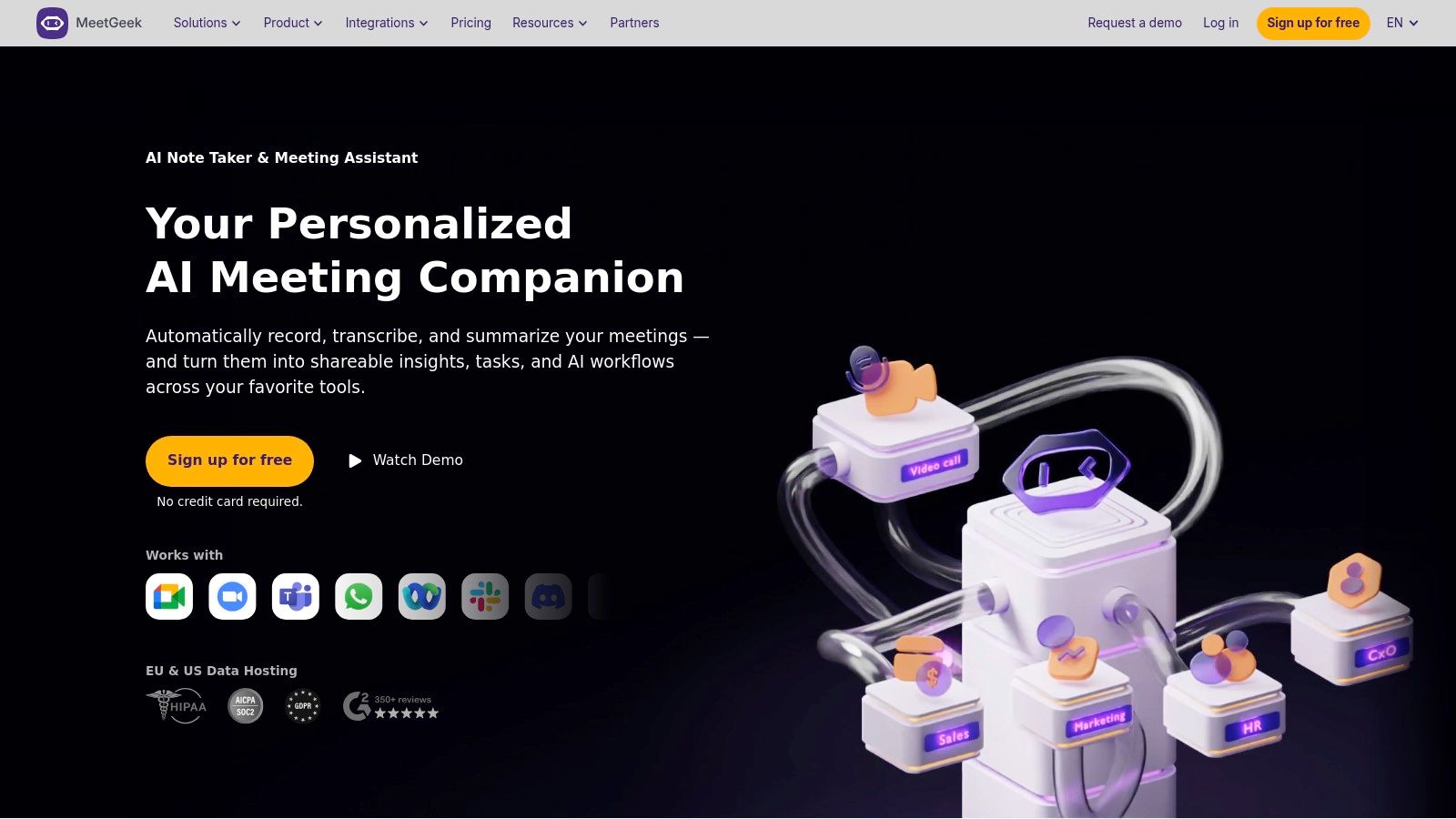
What I find most valuable is its ability to generate meeting highlights and structured summaries with impressive accuracy. After a call, MeetGeek sends an email with a concise overview, key takeaways, and a list of assigned tasks. This automated follow-up process ensures that everyone is on the same page and accountability is clear, transforming messy conversations into organised, actionable outcomes. For example, a project manager can use MeetGeek to automatically generate and share minutes for a daily stand-up, saving 15-20 minutes of administrative work each day.
Key Features & User Experience
- Automated Meeting Summaries: Generates concise summaries, highlights, and action items post-meeting.
- Multi-Platform Integration: Works seamlessly with Zoom, Google Meet, and Microsoft Teams.
- Meeting Analytics: Provides insights into meeting dynamics, such as talk-to-listen ratios and participant engagement.
- Multi-Language Support: Offers transcription and analysis in over 20 languages, including English, Spanish, and French.
The user interface is incredibly straightforward; you simply connect your calendar, and MeetGeek handles the rest. Finding past meetings and their associated notes is simple and intuitive.
Pricing and Practical Considerations
MeetGeek offers a free plan that includes five meetings per month and basic transcription. For more advanced features like custom branding and CRM integrations, paid plans begin with the Pro plan at $15 per user/month (billed annually). While the free tier is limited, it’s a great way to test the platform's core functionality. For teams that rely heavily on virtual meetings, the investment in a paid plan can yield significant productivity gains.
Pro Tip: Use MeetGeek's "Meeting Templates" feature. Before a recurring meeting, like a weekly sales check-in, I set up a template with specific keywords (e.g., "target," "pipeline," "blocker"). The AI then automatically flags and categorises these topics in the summary, making my review process much faster.
Website: https://meetgeek.ai/
7. Fathom
Fathom positions itself as one of the best AI note takers specifically designed for meetings. It excels by focusing purely on the video call experience, acting as a dedicated assistant that records, transcribes, and summarises conversations on platforms like Zoom, Google Meet, and Microsoft Teams. Its standout feature is the speed and accuracy with which it delivers post-meeting summaries, pulling out key action items and insights almost instantly after a call ends. This makes it an invaluable tool for client-facing roles or internal team catch-ups where quick follow-ups are critical.
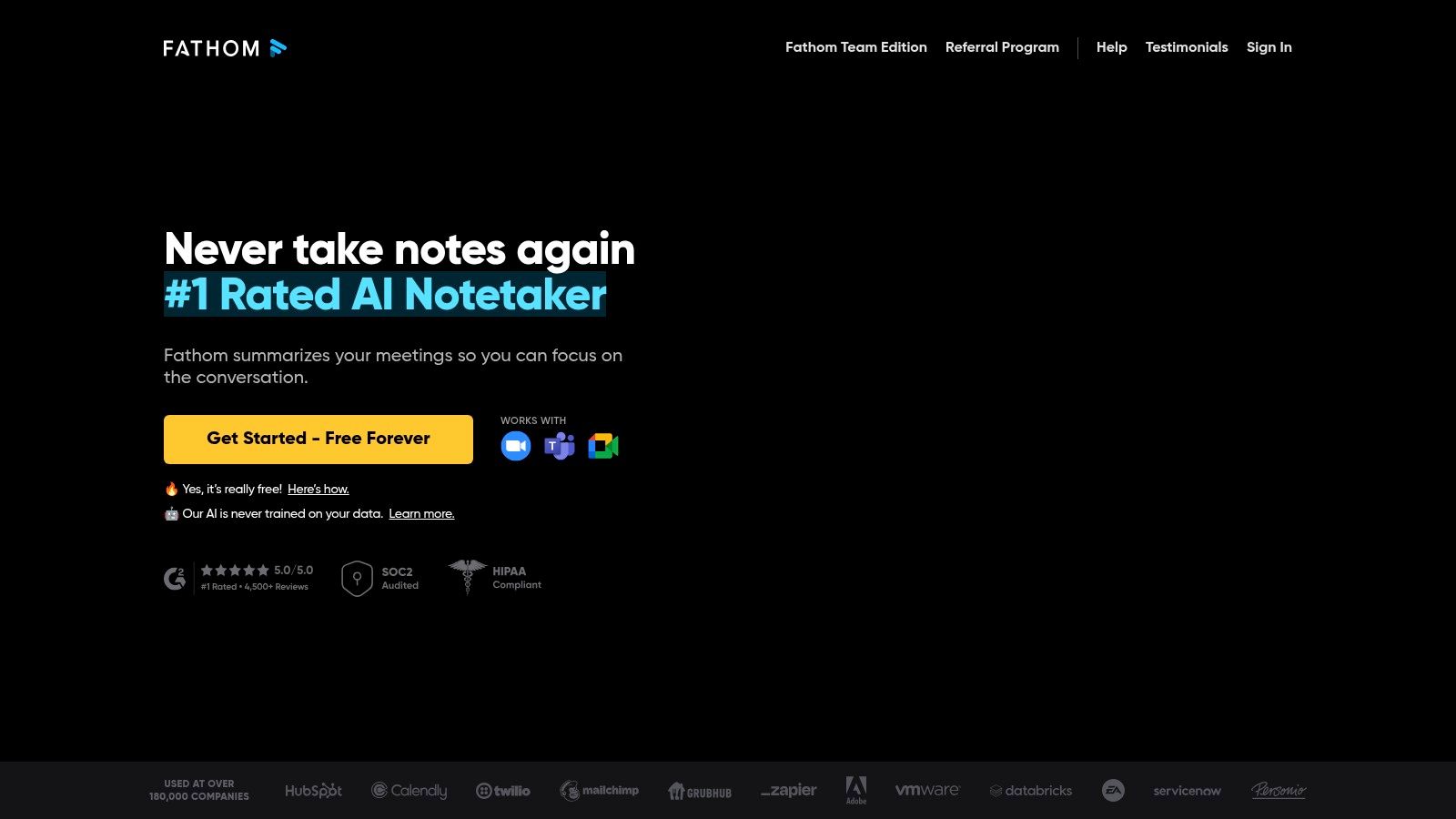
What makes Fathom particularly effective is its real-time functionality. During a meeting, I can click a button to highlight important moments, which the AI then uses to build a more relevant summary. This proactive approach ensures the final notes are not just a generic transcript but a focused brief on what truly matters. Its deep integrations with CRM and project management tools like HubSpot, Salesforce, and Asana mean that action items can be pushed directly into existing workflows with a single click. For example, during a sales call, I can highlight a client's feature request, and with one click after the call, Fathom creates a new task in Asana assigned to the product team, complete with a link to the transcript moment.
Key Features & User Experience
- Real-time Highlighting: Tag important moments during calls for focused summaries.
- Automated Summaries & Action Items: Generates concise notes and task lists immediately after a meeting.
- Extensive Integrations: Connects directly with popular CRM and task management software.
- Multi-language Support: Provides accurate transcription and summaries in seven different languages.
The user interface is incredibly simple and operates as a small overlay during your call, making it unobtrusive. Its seamless integration is a major plus, removing the manual work of transferring notes.
Pricing and Practical Considerations
Fathom offers a surprisingly robust free plan that includes unlimited recordings and transcriptions, making it highly accessible. For advanced features like CRM integration syncing and team-wide customisation, the Fathom Team Edition is required, which comes at a paid subscription starting from £12 per user/month. While the free plan is powerful, businesses relying on CRM workflows will need the paid tier to unlock Fathom's full potential.
Pro Tip: Before a call, customise your highlight buttons in Fathom's settings. I have presets for "Action Item," "Client Concern," and "Key Decision." This allows me to categorise insights on the fly, making the AI-generated summary even more organised and actionable.
Website: https://fathom.video/
8. Supernormal
Supernormal positions itself as one of the best AI note takers specifically designed to eliminate the drudgery of meeting documentation. It acts as an automated assistant for your video calls on platforms like Google Meet, Zoom, and Microsoft Teams, diligently transcribing conversations and generating structured, shareable notes. Its core strength lies in its simplicity and focus; it does one job, and it does it exceptionally well. The platform is built to provide instant, detailed summaries so you can focus on the conversation, not on typing.
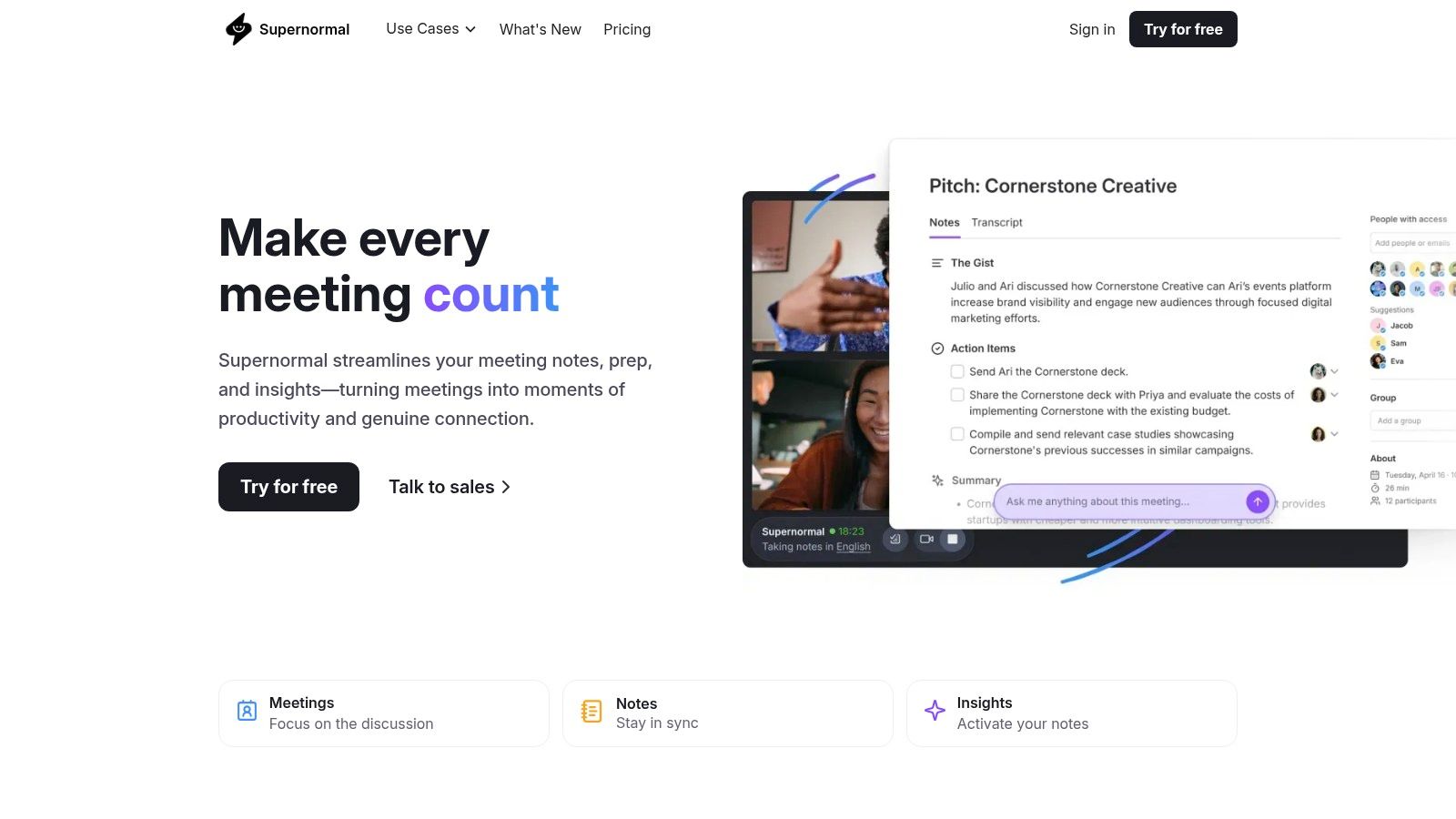
What makes Supernormal stand out is its ability to create notes in different formats automatically. After a call, I can instantly get a detailed summary, a list of action items, or a narrative recap. This is a massive time-saver, especially for back-to-back meetings. The AI is adept at pulling out key decisions and action points, which can then be shared directly to Slack or pushed into a CRM like Salesforce. For instance, a hiring manager can use Supernormal during interviews and instantly receive a structured summary based on a predefined template (e.g., 'Strengths', 'Weaknesses', 'Red Flags'), ensuring consistent evaluation across all candidates.
Key Features & User Experience
- Automatic Transcription & Summaries: Provides real-time transcription and creates instant, structured notes after meetings.
- Customisable Note Templates: Allows you to create and use templates to guide the AI, ensuring notes are formatted consistently for different meeting types (e.g., sales calls, team stand-ups).
- Action Item Detection: Intelligently identifies and lists actionable tasks discussed during the call.
- Seamless Integrations: Connects directly with popular tools including Slack, Salesforce, HubSpot, and Notion, streamlining workflows.
The user interface is incredibly clean and intuitive. You simply invite the Supernormal bot to your meeting, and it handles the rest.
Pricing and Practical Considerations
Supernormal offers a free starter plan that includes up to 30 minutes of recording per meeting, which is great for trying it out. For more advanced features and unlimited recording, the Pro plan is priced at $19 per user/month, with an annual option available for $10 per user/month. While the free plan has limitations, the paid tier unlocks its full potential, making it a valuable investment for professionals who spend a significant portion of their day in meetings.
Pro Tip: Spend time setting up custom templates for your recurring meeting types. I have a specific template for client discovery calls that instructs the AI to focus on budget, timeline, and key pain points. This ensures I get perfectly structured notes every single time without manual adjustments.
Website: https://supernormal.com/
9. Reflect Notes
Reflect Notes positions itself as a networked thought tool, a private and secure brain for your ideas, making it a unique entry among the best AI note takers. Its core philosophy centres on building connections between your notes, mirroring how the human brain works. This is supercharged with AI, allowing you to not only capture thoughts but to have the AI assistant help synthesise, summarise, or expand upon them, all within a privacy-first, end-to-end encrypted environment.
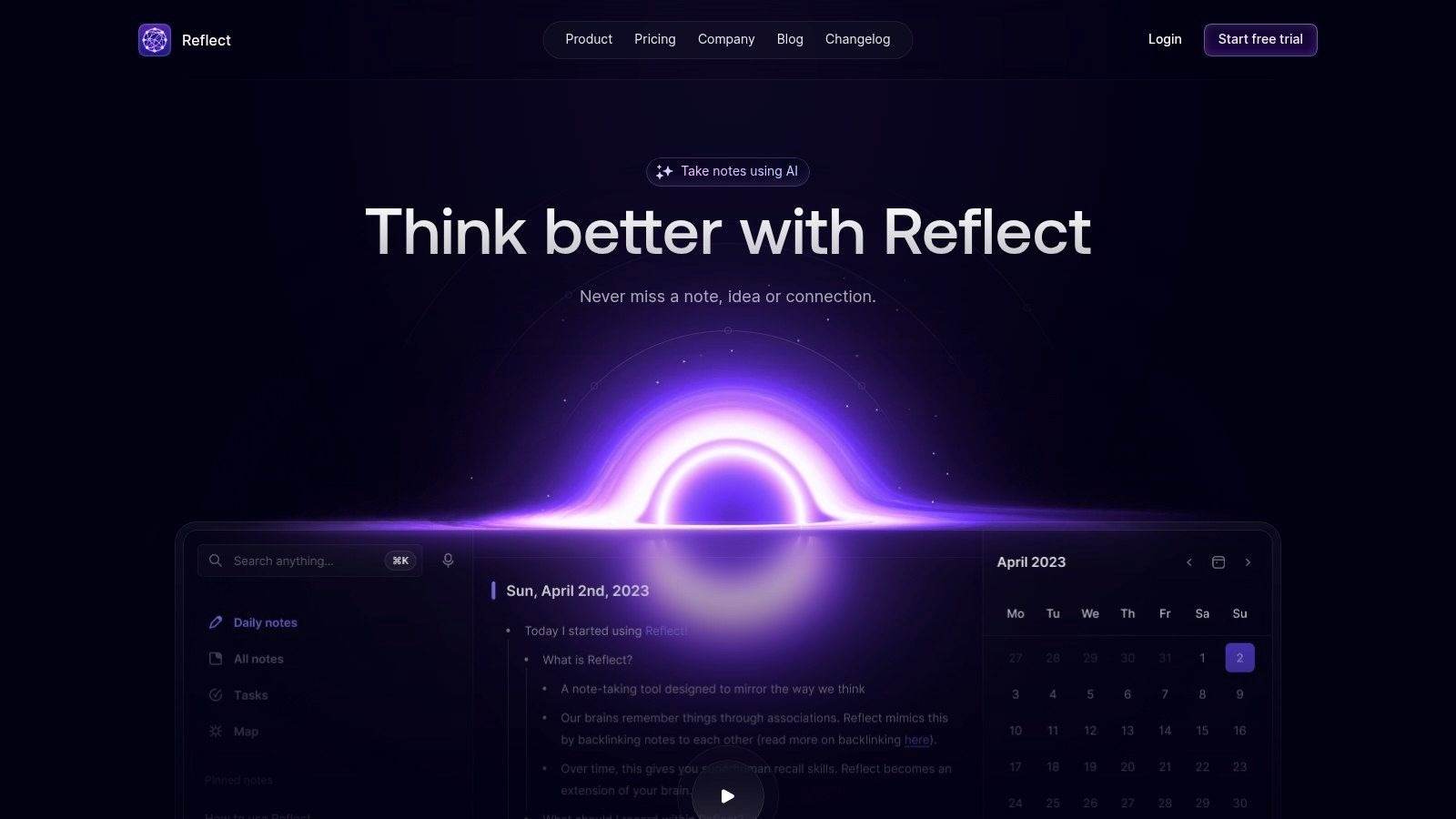
What makes Reflect stand out is its blend of speed, simplicity, and powerful integrations. It’s not just for text; its AI can transcribe voice notes, and it connects to services like Kindle to pull in your highlights automatically. For me, this means I can dictate a thought on the go, have it transcribed, and then use the AI to turn that raw idea into a structured paragraph, all linked to a relevant book highlight I made last week. Its philosophy aligns with the "Zettelkasten" method of note-taking, a concept popularised by sociologist Niklas Luhmann and discussed in books like Sönke Ahrens' How to Take Smart Notes.
Key Features & User Experience
- Networked Thought: Create backlinks between notes to build a web of connected knowledge.
- End-to-End Encryption: A strong focus on privacy ensures your notes remain secure and private.
- AI-Assisted Writing & Transcription: Generate content, summarise notes, and transcribe voice memos directly within the app.
- Seamless Integrations: Connects with Kindle, Calendar, and contacts to centralise your information.
The interface is exceptionally clean and fast, designed to remove friction from the note-taking process. The lack of an Android app is a notable drawback for users outside the Apple ecosystem.
Pricing and Practical Considerations
Reflect offers a 14-day free trial to test all its features. After the trial, access requires a subscription, which is priced at $10 per month but is billed annually at $120. There is currently no monthly subscription option, which might be a barrier for some users. This all-or-nothing approach is best suited for those fully committed to its networked-thought methodology.
Pro Tip: Use the daily note feature as your starting point. Capture fleeting thoughts, meeting notes, and tasks there. Then, use the backlinking
[[ ]]feature to connect these daily entries to permanent topic notes. This creates an organised, searchable "second brain" over time.
Website: https://reflect.app/
10. Krisp
While many tools on this list focus on the post-meeting summary, Krisp distinguishes itself by tackling a critical, real-time problem first: audio clarity. It started as a phenomenal noise-cancelling app and has since evolved into one of the best AI note takers by building on that foundation. Krisp uses AI to eliminate background noise and echoes from your calls, ensuring every word is captured clearly before it even gets transcribed. This focus on pristine audio input leads to remarkably accurate meeting notes and summaries.
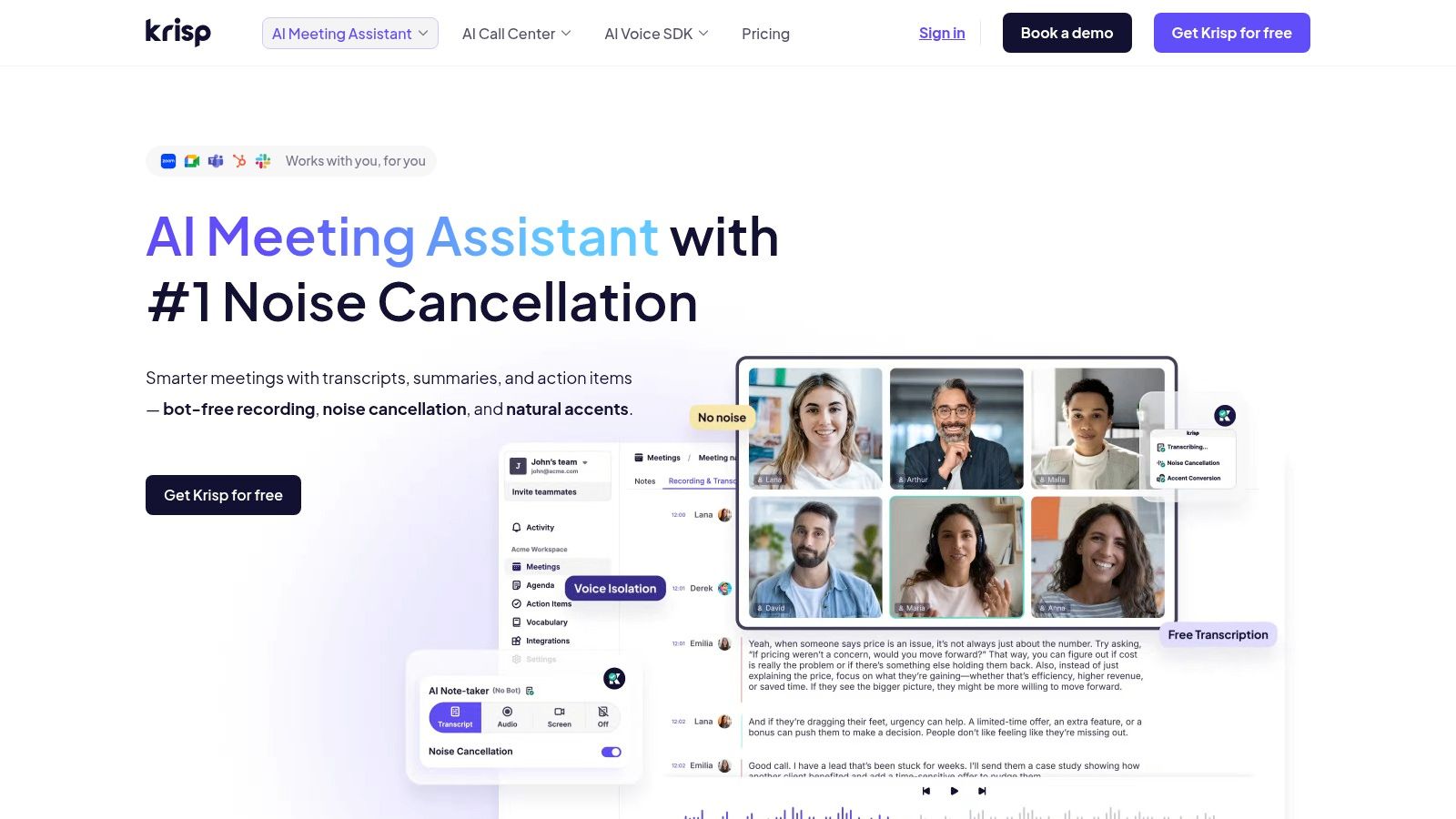
What makes Krisp unique is its role as a pre-processor for your meetings. It sits between your microphone and your meeting app (like Zoom or Teams), cleaning up the audio for everyone involved. The AI then generates transcriptions and concise, actionable summaries from this high-quality source. I find this particularly useful when participants are in noisy environments, such as a coffee shop or home office with children playing. Krisp ensures their contributions aren't lost in the final notes, a problem that often plagues other transcription services.
Key Features & User Experience
- AI-Powered Noise Cancellation: Removes background noises, echoes, and interruptions in real time.
- Automatic Transcription & Summarisation: Generates accurate transcripts and distils them into key points and action items.
- Seamless Integration: Works as a middleware app with virtually all major communication platforms like Google Meet, Slack, and Zoom.
- Action Item Detection: The AI specifically identifies and lists out tasks discussed during the call.
The user interface is a simple, unobtrusive desktop app that’s easy to configure. You simply select Krisp as your microphone and speaker in your meeting software, and it handles the rest.
Pricing and Practical Considerations
Krisp offers a free plan that includes a limited amount of noise cancellation and transcription minutes per day. The Pro plan, which unlocks unlimited usage and advanced features, starts at £8 per user/month (billed annually). The true value lies in its dual-purpose functionality: enhancing call quality and providing automated notes. While its note-taking features are not as customisable as a platform like Notion, its audio-first approach ensures the notes it does take are incredibly precise.
Pro Tip: Before an important client call, run a test recording with Krisp to ensure it's properly configured as your default audio device in your meeting app. This guarantees both crystal-clear audio and a flawless, automated transcript from the moment the meeting begins.
Website: https://krisp.ai/
11. Mem AI
Mem AI positions itself as your personal, self-organising workspace, functioning more like a ‘second brain’ than a traditional note-taking app. It excels at making connections you might have missed, using AI to surface related notes and information automatically. This makes it one of the best AI note takers for those who value discovery and serendipity in their workflow. Instead of manually linking or tagging every piece of information, Mem’s AI does the heavy lifting, connecting meeting notes to project briefs or brainstorming sessions to relevant research you saved weeks ago.
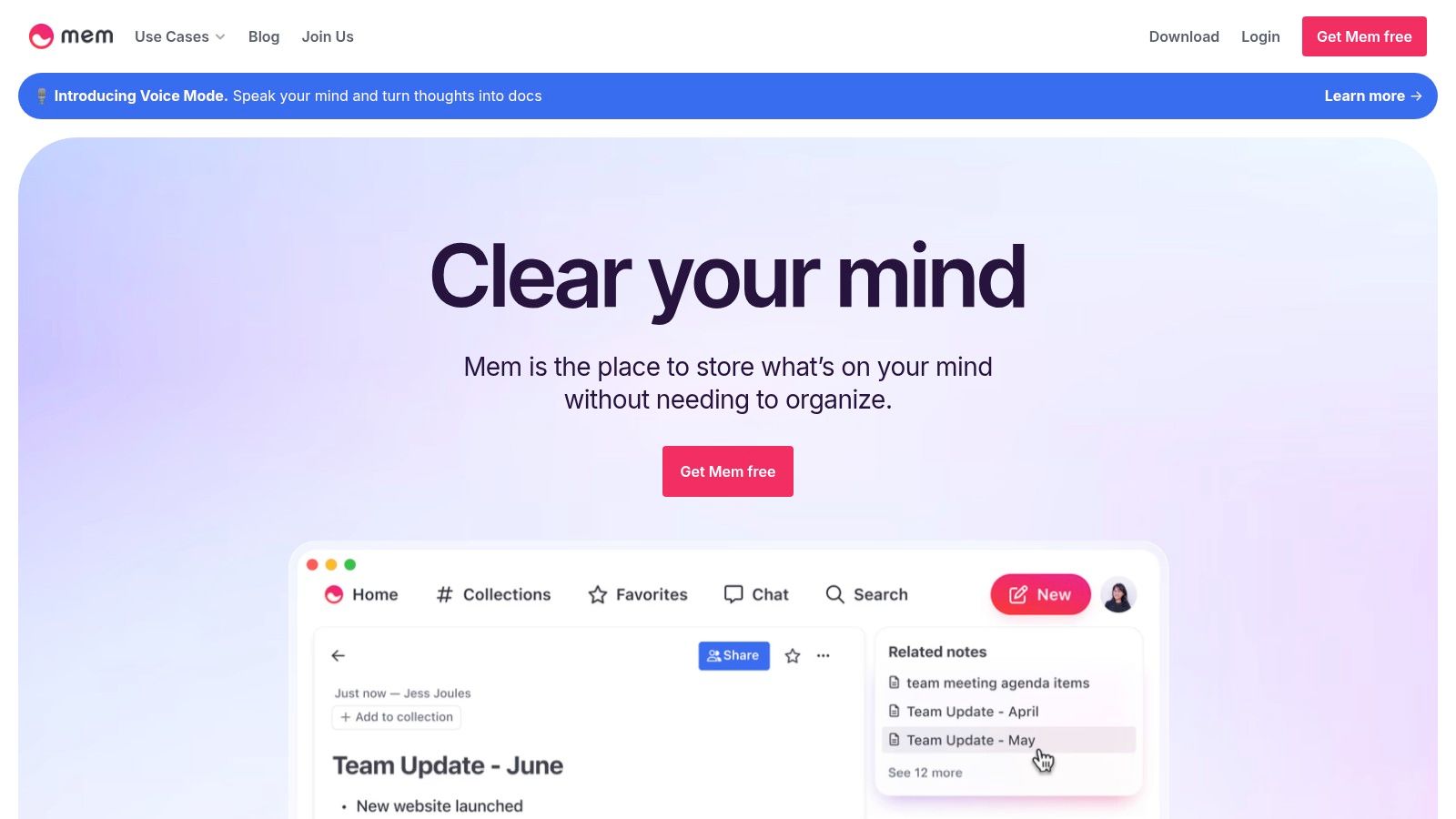
What makes Mem truly stand out is its focus on effortless knowledge retrieval. The platform is designed to reduce the friction between thinking and capturing, and later, between needing information and finding it. I find its ‘Similar Mems’ feature particularly powerful; it acts like a research assistant, presenting relevant context without me having to search for it. For a deeper dive into organising digital information, you can explore key learnings from saved content. This aligns with the principles of Personal Knowledge Management (PKM), a field gaining traction as information overload becomes a greater challenge.
Key Features & User Experience
- AI-Powered Organisation: Automatically links related notes, creating an interconnected knowledge base.
- Intelligent Search: Go beyond keywords with a search that understands context and relationships between notes.
- Real-time Syncing: Notes are instantly available and updated across all your devices.
- Collaborative Spaces: Share notes and ‘Mems’ with team members to work on projects together.
The interface is minimalist and fast, prioritising speed of capture. It’s incredibly intuitive for getting thoughts down quickly, with AI features working quietly in the background.
Pricing and Practical Considerations
Mem offers a free plan with core note-taking features. The Mem X plan, which unlocks the full suite of AI capabilities like smart search and organisation, is priced at $10 per month (billed annually). The Mem X for Teams plan adds collaborative features. The main limitation is its relatively few direct integrations with other apps, relying more on its own ecosystem. However, for users seeking an intelligent, self-organising notebook, it’s a powerful choice.
Pro Tip: Use the timeline view to see your notes chronologically. This is a fantastic way to retrace your thought process over a day or week and see how ideas have evolved and connected over time, often revealing patterns you wouldn't have noticed otherwise.
Website: https://mem.ai/
12. Microsoft OneNote with Copilot
For professionals deeply embedded in the Microsoft ecosystem, the integration of Copilot transforms OneNote into one of the best AI note takers available. Rather than a standalone tool, its power comes from being part of the wider Microsoft 365 suite. This allows Copilot to pull context from your emails, calendar, and Teams chats to generate smarter, more relevant notes and summaries directly within OneNote’s flexible, free-form canvas.
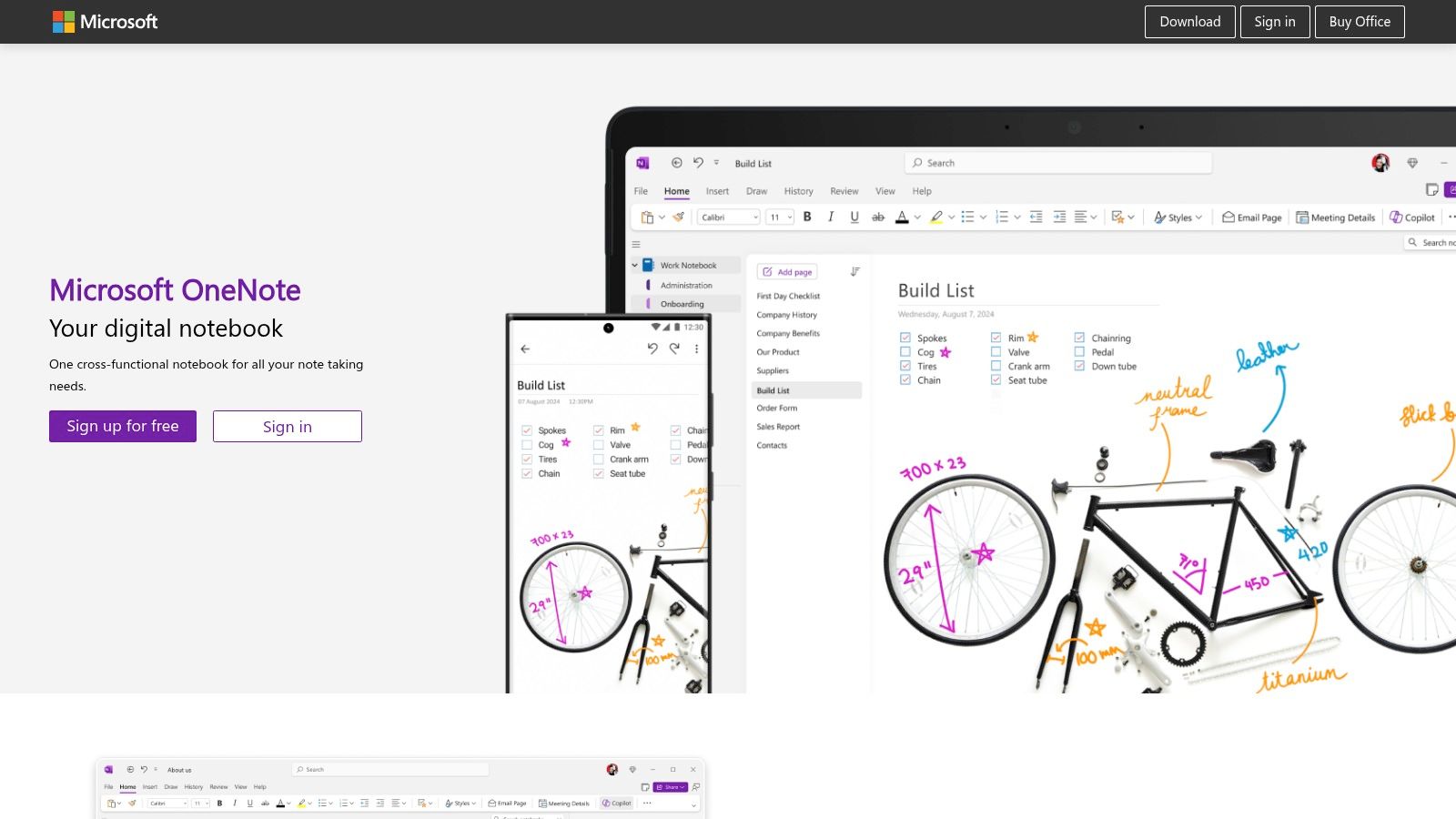
What makes OneNote with Copilot stand out is its deep, contextual integration and versatility. I often use it to create meeting agendas by simply asking Copilot to pull key discussion points from a related email thread in Outlook. The AI can then summarise the meeting notes and even generate a list of action items, which can be tracked in Microsoft To Do or Planner, creating a seamless workflow across applications. A recent Forrester report on The Total Economic Impact™ Of Microsoft 365 Copilot found that information workers saved an average of 14 minutes per day, with much of that time saved on tasks like summarising meetings and finding information.
Key Features & User Experience
- AI-powered Summaries and Insights: Copilot can condense long pages of notes, highlight key takeaways, and generate to-do lists from unstructured text.
- Deep Microsoft 365 Integration: Seamlessly works with Outlook, Teams, and Word, allowing for cross-app data retrieval and task creation.
- Multi-Modal Input: Supports typed text, digital ink from a stylus, images, and voice recordings all on the same page.
- Secure Cloud Storage: All notes are securely stored and synchronised across devices via OneDrive.
The user interface remains the familiar OneNote canvas, which can feel cluttered for newcomers but offers unparalleled flexibility. Copilot is activated via a dedicated button, making it easy to access its features without disrupting your flow.
Pricing and Practical Considerations
OneNote itself is free, but accessing Copilot requires a Microsoft 365 subscription (Business Standard/Premium or E3/E5 plans) plus a specific Copilot for Microsoft 365 licence, which costs around £24.70 per user/month. This makes it a significant investment primarily suited for businesses already committed to the Microsoft platform. For individual users or those outside this ecosystem, the cost may be prohibitive.
Pro Tip: Use the "Summarise" feature in Copilot before sharing a notebook with colleagues. I do this to provide a quick, AI-generated executive summary at the top of a project notebook, which saves my team valuable time getting up to speed.
Website: https://www.onenote.com/
Top 12 AI Note Takers Feature Comparison
| Tool | Core Features | User Experience | Value Proposition | Target Audience | Price Points |
|---|---|---|---|---|---|
| Notion | AI content generation, templates, collaboration | User-friendly, regular updates | All-in-one productivity tool | Individuals & teams | Free + subscription for advanced |
| Otter.ai | Live transcription, speaker ID, meeting summaries | Easy to use, high accuracy | Real-time searchable transcripts | Meeting attendees, students | Free plan with limits |
| Fireflies.ai | Auto transcription, summarization, integrations | User-friendly, efficient | Simplifies meeting docs | Teams & remote workers | Free plan, paid tiers |
| ClickUp | AI notetaker, customizable workspace, integrations | Highly customizable, steep learning | Comprehensive project mgmt | Teams & project managers | Free + subscription |
| Notta | Real-time transcription, 58 languages, integrations | User-friendly, accurate | Multilingual transcription | Global, multilingual users | Affordable paid plans |
| MeetGeek | Transcription, summarization, analytics | Easy interface, multilingual support | Meeting insights and analysis | Teams & SMEs | Free plan, paid options |
| Fathom | Fast AI summaries, CRM/task integrations | User-friendly, seamless workflow | Workflow integration + summaries | Sales & customer teams | Free plan, subscription |
| Supernormal | Auto transcription, structured summaries, integrations | Efficient, easy to use | Automated meeting notes | Teams & managers | Free plan, subscription |
| Reflect Notes | Encrypted notes, voice transcription, Kindle integration | Simple, fast, secure | Privacy-focused note-taking | Privacy-conscious users | Affordable pricing |
| Krisp | Noise removal, accurate transcription, summaries | User-friendly, enhances audio | Improved virtual meeting quality | Remote workers & communicators | Free plan, paid plans |
| Mem AI | AI search, dynamic linking, real-time sync | Intuitive, AI-driven insights | AI “second brain” for notes | Knowledge workers & teams | Free + paid subscription |
| Microsoft OneNote with Copilot | AI summaries, MS 365 integration, multi-input | Versatile but complex for new users | Integrated in Microsoft 365 | Microsoft 365 users | Requires Microsoft 365 subscription |
Final Thoughts
Navigating the landscape of AI-powered productivity tools can feel overwhelming, but as we've explored, the journey to finding the best AI note taker for your specific needs is more achievable than ever. The twelve tools I've detailed, from comprehensive project hubs like Notion and ClickUp to specialised meeting assistants like Fireflies.ai and Fathom, represent the forefront of a technological revolution. This shift is fundamentally changing how we capture, organise, and utilise information.
The core takeaway from this in-depth analysis is that there is no single, definitive "best" tool for everyone. The ideal solution is deeply personal and context-dependent. A freelance consultant who spends their day in back-to-back client calls will find immense value in an automatic transcription and summarisation tool like Otter.ai or Notta. Conversely, a creative strategist or developer will likely gravitate towards a "second brain" system like Mem AI or Reflect Notes, which excels at connecting disparate ideas and fostering long-term knowledge management.
Making Your Choice: A Practical Framework
To move from analysis to action, it’s crucial to crystallise your own requirements. Before you commit to a subscription or invest time in a new system, I encourage you to undertake a personal audit. Consider these critical factors:
- Primary Use Case: Are you trying to solve the problem of messy meeting notes, or are you building a long-term, searchable knowledge base? Is your priority real-time transcription, or is it the ability to synthesise information after the fact? Be honest about the single biggest pain point you want to eliminate.
- Integration Ecosystem: Your new AI note taker should not become another isolated information silo. Scrutinise how well it integrates with your existing workflow. Does it connect seamlessly with your calendar (Google, Outlook), your communication platform (Slack, Teams), and your project management software (Asana, Trello, ClickUp)? A tool that works with your current setup, not against it, will have a much higher adoption rate.
- Collaboration vs. Solo Work: How many people will need to access and interact with your notes? Tools like ClickUp and Notion are built from the ground up for team collaboration, offering granular permissions and shared workspaces. In contrast, tools like Reflect Notes are designed primarily for individual thought and personal knowledge management.
- Budget and Scalability: Start with a free trial or a freemium plan whenever possible. This is non-negotiable. Real-world usage is the only way to determine if a tool’s interface and functionality resonate with you. Assess the pricing tiers and consider what features you might need as your business or project grows.
Implementing Your New AI Assistant
Once you've made your selection, successful implementation is key. Don’t try to migrate your entire life’s work into the new system overnight. Start small. Pick one specific recurring task, like your weekly team meeting or a client discovery call, and use the new AI note taker exclusively for that purpose. This focused approach allows you to learn the tool's nuances in a low-stakes environment.
Remember that these tools are designed to augment your intelligence, not replace it. The AI-generated summaries and action items are a starting point. It's your human insight that provides the context, refines the key takeaways, and makes the strategic connections that the AI might miss. The true power of the best AI note takers is unlocked when they are treated as a partner in your thinking process, freeing up your cognitive bandwidth to focus on what truly matters: creative problem-solving, strategic planning, and building meaningful relationships. The right tool will feel less like a piece of software and more like an extension of your own mind.
Feeling inspired to enhance your digital productivity but need guidance on integrating these tools into a wider marketing and business growth strategy? At Mersudin Forbes Digital, I specialise in helping businesses harness the power of technology and SEO to build a formidable online presence. Let's connect and explore how a streamlined, tech-powered workflow can fuel your growth.


